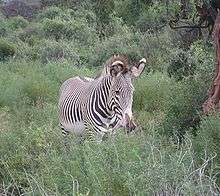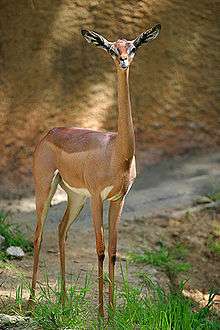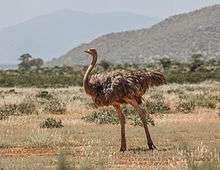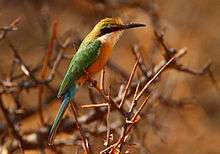Wildlife of Somalia
The country has a long coastline, bordering the Indian ocean in the east and Red Sea in the north.The Northeastern and Central parts of this country are arid, or very dry. The Southern and Northwestern regions are semi-arid, receiving slightly more rainfall than the Central and Northeastern regions. The Coastal region is more humid due to its proximity to the ocean. Somalia is home to a large number of birds It has over 727 species of birds and boasts over 177 species of mammals.
The Nile crocodile is very common in southern Somalia. It's the largest crocodilian found in Africa. Somalia is home to a diverse variety of flora and fauna, from acacia trees, to birds, large cats, and reptiles large and small.
In some areas, the mountains are covered with shrubs such as pyracantha, jasmine, poinsettia, and a varied assortment of evergreens. Caraway, carcade, cardamom, coriander, incense, myrrh, and red pepper are common.
Fauna
Mammals
Somalia contains a variety of mammals due to its geographical and climatic diversity. Wild animals are found in every region. Among the latter are the cheetah, lion, giraffe, baboons, civet, serval, African bush elephant, bushpig, gazelle, antelope, ibex, kudu, dik-dik, oribi, reedbuck, wild ass donkey, Grévy's zebra, hyena, baboon.
Elephants are also found here. Since elephants are migratory, they are found in a variety of habitats, such as woodland, savanna, and tropical forests. elephant shrew, are found only in Somalia. Somalia is home to a diverse variety of flora and fauna, from acacia trees, to birds, primates, large cats, and reptiles large and small. The yellow-spotted rock hyrax, which is found in savanna and rocky areas, looks much like a large rodent, but is actually related to elephants. The savanna-dwelling golden mole, and the shrub-land and desert-dwelling.[1]
list of mammal species found exclusively in Somalia
Birds
Reptiles
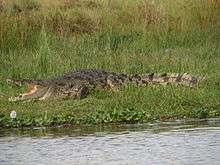
Somalia has roughly 235 species of reptiles, of which almost a half live in its northern areas. The Nile crocodile is very common in southern Somalia. It's the largest crocodilian found in Africa. Adult males can grow to between 12 and 16 feet long.
other Reptiles unique to Somalia include the Hughes' Saw-scaled snake, the Southern Somali Garter Snake ,a racer Platyceps messanai, a diadem snake Spalerosophis josephscorteccii, the Somali Sand Boa the Angled Worm Lizard Agamodon anguliceps, a spiny-tailed lizard Uromastyx macfadyeni, Lanza's Agama, a gecko Hemidactylus granchii, the Semaphore Gecko, and a sand lizard Mesalina or Eremias. A colubrid snake Aprosdoketophis andreonei and Haacke-Greer's Skink Haackgreerius miopus are endemic genera.[2]
Fish
With 3 300 km of coastline facing the Indian Ocean, Somalia has the longest coastline in continental Africa. Somali waters are prime fishing grounds for highly migratory fish species such as tuna and tuna-like species, and a narrow but productive continental shelf is the home to several demersal fish and crustacean species.[3]
Fish species found exclusively in Somalia include :
- Cirrhitichthys randalli Cirrhitidae
- Symphurus fuscus Cynoglossidae
- Parapercis simulata OC Pinguipedidae
- Cociella somaliensis OC Platycephalidae
- Pseudochromis melanotus Pseudochromidae
Flora
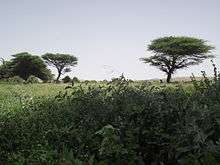
The highlands, which in an almost continuous line traverse East Africa, have to a great extent isolated the flora of Somalia in spite of the general resemblance of its climate and soil to the country on the western side of the band of high ground. The greater part of the country is covered either with tall coarse grasses, or more commonly with thick thorn-bush or jungle, among which rise occasional isolated, trees. The prevalent bush plants are khansa, acacias, aloes, and, especially, Boswellia and Commiphora, which yield highly fragrant resins and balsams, such as myrrh, frankincense (olibanum) and balm of Gilead.
Among the larger trees are the mountain cedar, reaching to 100 ft.; the gob, which bears edible berries in appearance something like the cherry with the taste of an apple, grows to some 80 ft., and is found fringing the river beds; There are patches of dense reeds, reaching 10 ft. high, and thickets of tamarisk along the river beds, and on either side the jungle is high and more luxuriant than on the open plateau. Of herbaceous plants the kissenia, the sole representative of the order Loasaceae, ‘which is common in America but very rare elsewhere, is found in Somalia, which also possesses forms belonging to the eastern Mediterranean flora.
vascular plant genera found exclusively in Somalia:[4]
- Eriostylos 1 spp. Amaranthaceae
- Polyrhabda 1 spp. Amaranthaceae
- Goydera 1 spp. Apocynaceae
- Whitesloanea 1 spp. Apocynaceae
- Puccionia 1 spp. Cleomaceae
- Afrotrichloris 2 spp. Gramineae
- Pseudozoysia 1 spp. Gramineae
- Taeniorhachis 1 spp. Gramineae
- Renschia 1 spp. Labiatae
- Symphyochlamys 1 spp. Malvaceae.

Notes
- ↑ Wilson, D.E. & Reeder, D.M. (Eds.)(2005) Mammal Species of the World: A Taxonomic and Geographic Reference. Third Edition. The Johns Hopkins University Press, Baltimore.
- ↑ Uetz, P. & Jirí Hošek (eds.), The Reptile Database, htUetz, P. & Jirí Hošek (e Uetz, P. & Jirí Hošek (eds.), The Reptile Database, http://www.reptile-database.org, accessed Dec 8, 2013
- ↑ FishBase 2004: a global information system on fishes. DVD. WorldFish Center - Philippine Office, Los Banos, Philippines. Published in May 2004
- ↑ Mabberley, D.J. (2008) Mabberley's Plant-book. Third Edition. Cambridge University Press, Cambridge.
References
- Wilson, Don E.; Reeder, DeeAnn M., eds. (2005). Mammal Species of the World: A Taxonomic and Geographic Reference (3rd ed). Johns Hopkins University Press. Retrieved 3 August 2009.
- "Animal Diversity Web". University of Michigan Museum of Zoology. 1995–2006. Retrieved 22 May 2007.

